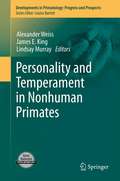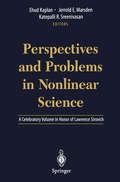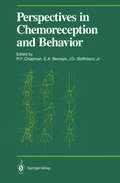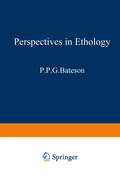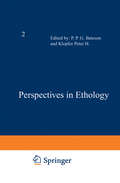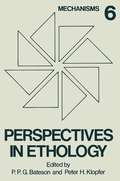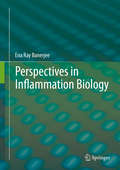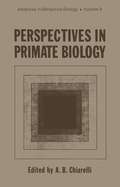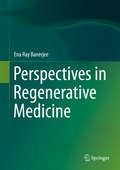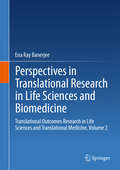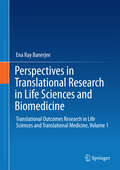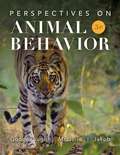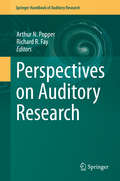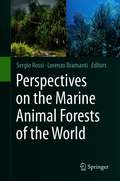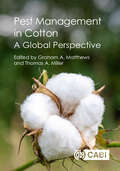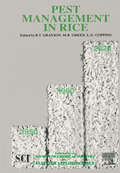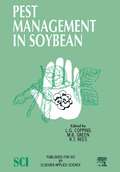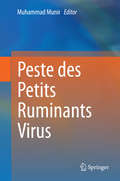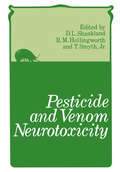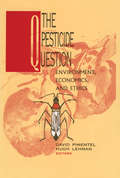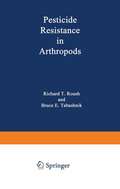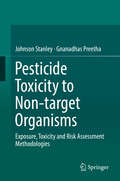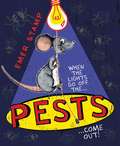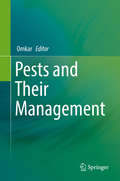- Table View
- List View
Personality and Temperament in Nonhuman Primates (Developments in Primatology: Progress and Prospects)
by Alexander Weiss, James E. King and Lindsay MurrayRecently, there has been an increased interest in research on personality, temperament, and behavioral syndromes (henceforth to be referred to as personality) in nonhuman primates and other animals. This follows, in part, from a general interest in the subject matter and the realization that individual differences, once consigned to ‘error’ terms in statistical analyses, are potentially important predictors, moderators, and mediators of a wide variety of outcomes ranging from the results of experiments to health to enrichment programs. Unfortunately, while there is a burgeoning interest in the subject matter, findings have been reported in a diverse number of journals and most of the methodological and statistical approaches were developed in research on human personality. The proposed volume seeks to gather submissions from a variety of specialists in research on individual differences in primate temperament, personality, or behavioral syndromes. We anticipate that chapters will cover several areas. The first part of this edited volume will focus on methodological considerations including the advantages and disadvantages of different means of assessing these constructs in primates and introduce some statistical approaches that have typically been the domain of human personality research. Another part of this edited volume will focus on present findings including the physiological and genetic bases of personality dimensions in primates; the relationship between personality and age; how personality may moderate or impact various outcomes including behavior, health, and well-being in captive and non-captive environments. For the third part of the volume we hope to obtain summaries of the existing work of the authors on the evolutionary important of personality dimensions and guideposts for future directions in this new and exciting area of research.
Perspectives and Applications of Indigenous Small Fish in India: An Introduction
by Archana Sinha Aparna Roy Pranab GogoiThis contributed volume covers all aspects of small indigenous fish for nutritional and livelihood security. The availability, descriptions and identification of common small indigenous fish provides potential and prospects of fish production from inland open water system. In addition, individual chapters are added on growth, feeding, diseases and health management of these small fishes. Essential information is provided on packaging and transport of these fishes. Specific chapters provide information on nutritional value of fishes, value addition and product development by using small indigenous fish species in different regions of the country. Further topics include small fishes of ornamental value, indigenous technical knowledge, climate change impact, conservation and management of small indigenous fish diversity. This book supports the academicians, farmers, entrepreneurs and fisheries professionals involved in gaining the knowledge and skills needed to contribute in nutritional and livelihood security of the nation.
Perspectives and Problems in Nonlinear Science: A Celebratory Volume in Honor of Lawrence Sirovich
by Ehud Kaplan Jerrold E. Marsden Katepalli R. SreenivasanLawrence Sirovich will turn seventy on March 1, 2003. Larry's academic life of over 45 years at the Courant Institute, Brown University, Rockefeller University and the Mount Sinai School of Medicine has touched many peo ple and several disciplines, from fluid dynamics to brain theory. His con tributions to the kinetic theory of gases, methods of applied mathematics, theoretical fluid dynamics, hydrodynamic turbulence, the biophysics of vi sion and the dynamics of neuronal populations, represent the creative work of an outstanding scholar who was stimulated mostly by insatiable curios ity. As a scientist, Larry has consistently offered fresh outlooks on classical and difficult subjects, and moved into new fields effortlessly. He delights in what he knows and does, and sets no artificial boundaries to the range of his inquiry. Among the more than fifty or so Ph. D. students and post docs that he has mentored, many continue to make first-rate contributions themselves and hold academic positions in the US and elsewhere. Larry's scientific collaborators are numerous and distinguished. Those of us who have known him well will agree that Larry's charm, above all, is his taste, wit, and grace under fire. Larry has contributed immensely to mathematics publishing. He be gan his career with Springer by founding the Applied Mathematical Sci ences series together with Fritz John and Joe LaSalle some 30 years ago. Later he co-founded the Texts in Applied Mathematics series and more re cently the Interdisciplinary Applied Mathematics series.
Perspectives in Chemoreception and Behavior: Papers Presented at a Symposium Held at the University of Massachusetts, Amherst in May 1985 (Proceedings in Life Sciences)
by E. A. BernaysIn the study of the physiological basis of animal behavior Vince Dethier has been a pioneer, a guiding star. Although his own work has centered on the blowfly and the caterpillar, his interests and influence have spread far beyond the insects. The breadth of this impact is indicated by the contributions from colleagues and former students in this volume. These papers were originally presented at a meeting to honor Vince's 70th birthday held at the University of Massachusetts, Amherst, in May 1985. It was attended by friends and col leagues of all ages from many parts of the world. However, the picture presented by these papers is not the whole story. What it does not show is the extent of Vince's interest and influence beyond the rigorous, though friendly, atmosphere of the research laboratory. His idyllic summers in Maine have produced studies on the natural history of feeding by insects culminating in The Tent Makers, with more to come. In these studies we see his real love and, dare we say, understanding of the insect. Vince Dethier is not concerned simply with reaching the established scientist. In To Know a Fly he reaches out to those just beginning, perhaps even to those who will never begin, and provides insight both to the experimentalist's approach and to the fun of research. His sense of fun and his elegant, fluent writing have given us, too, his tongue-in-cheek fictional writings for children of all ages.
Perspectives in Ethology
by P. BatesonIn the early days of ethology, most of the major developments were in the realm of ideas and in the framework in which animal behavior was studied. Much of the evidence was anecdotal, much of the thinking intuitive. As the subject developed, theories had to be tested, language had to become more public than it had been, and quantitative descriptions had to replace the preliminary qualitative accounts. That is the way a science develops; hard headed analysis follows soft-headed synthesis. There are limits, though, to the usefulness of this trend. The requirement to be quantitative can mean that easy measures are chosen at the expense of representing the complexly patterned nature of a phenomenon. All too easily the process of data collec tion becomes a trivial exercise in describing the obvious or the irrelevant. Editors and their referees require authors to maintain high standards of evidence and avoid undue speculation-in short, to maintain professional respectability. In the main, this process is admirable and necessary, but somewhere along the line perspective is lost and a body of knowledge, with all the preconceptions and intellectual baggage that comes with it, becomes formally established. New ideas are treated as though they were subversive agents-as indeed they often are.
Perspectives in Ethology: Volume 2 (Perspectives in Ethology)
by P. BatesonIn the preface to the first volume of this series we set out our aims, which were to encourage fresh perspectives in ethology and provide a forum for new ideas. We still feel that in the perfectly proper search for high stan dards of evidence, methodology has tended to remain the master rather than the servant of most aspects of ethological work. It is easy for us all to forget that the kinds of data we collect are largely determined by the kinds of questions we ask. Even an ethologist with the professed goal of providing a straightforward account of behavior must incorporate into his or her descriptions a great many assumptions about the organization of that be havior. Inevitably some facets of what went on will have been selected at the expense of others. This is sometimes done, for example, in the service of a theory that the fundamental unit for description is the fixed action pattern. Our point is not that constraints on the collection of data are bad but that the theory which gives rise to the selection of evidence should not be neglected. In the first volume, the choice of topics and authors was based upon our views about the exciting or developing issues in ethology. This volume represents a more opportunistic approach: the articles were selected from among the many offered to us as best conforming to our aims. Neverthe less, certain themes do emerge.
Perspectives in Ethology: Volume 6 Mechanisms
by P. BatesonWhen we began this series we wanted to encourage imaginative thinking among ethologists and those working in related fields. By the time we had reached Volume 3, we were advised by our publishers to give each volume a theme. Although we accepted the advice, it ran somewhat counter to our own wish to give our authors full rein. It also meant that we could not accept submitted manuscripts if they lay too far outside the topic for the next volume. We did, however, cheat a little, and faithful followers of the series will have noticed that some of the contributions were not exactly on the stated theme. Anyway, our publishers have now agreed that we can make honest people of ourselves by once again ac cepting a broad range of manuscripts for any volume. We shall also solicit manuscripts on particular topics that seem to be timely and appropriate, and each volume will continue to have a subtitle that relates to the theme of the majority of the papers in the volume. We hope that with our more permissive policy now explicit, potential contributors will feel encouraged to submit manuscripts to either of us at the addresses given at the end of this Preface. When planning the present volume, we wanted our contributors to build bridges between studies of behavior and the neurosciences. In recent years, the majority of people working on behavior seem to have been exclusively concerned with functional and evolutionary approaches.
Perspectives in Inflammation Biology
by Ena Ray Banerjee“Perspectives in Inflammation Biology” outlines detailed studies using preclinical murine models in Inflammation. The book is meant for academicians, industry persons, research scholars and students alike. The detailed perspective for a beginner and the exhaustive methodologies and analyses outlined, for the veteran researcher, makes this book a unique link between someone who is thinking of embarking on a study of inflammation and one who is delving deep into this area of specialization. The book deals with asthma and allergy as specific disease areas of inflammation of the lung, aseptic peritonitis as a disease of systemic inflammation and details how each role player in its pathophysiology has a unique niche of activity. Data acquisition, sequentiality and analyses in context demonstrate how each role player is validated systematically to become a target for drug discovery. Methods and models used in the course of my work and their relevance will demonstrate to the researcher how a study can be developed from an idea. Further into a researcher’s ongoing work, this book is meant to stimulate new questions and pave ways for better dissection of a phenomenon. The highlights of this book are the detailed tables tabulating sub species of immune cells, their inflammatory recruitment indices, their translation into tissue-to-tissue traffic of the inflammatory stimulus and the delicate interplay of resident structural cells, cells recruited from circulation, their feedback poiesis in bone marrow, their instruction in the lymphoid organs and tissues as well as the non-cellular mediators synthesized from corresponding genetic instruction. The book shall definitely help students and researchers how a disease can be simplified from its complex ramifications and network of implications and put back into perspective and the whole thing falls into place without an intimate understanding of the mechanism and the compelling circumstances that causes a disease, a drug hunter cannot hope to begin her quest. To find the “Achilles’ heel” and effectively neutralize the enemy!
Perspectives in Primate Biology (Advances in Behavioral Biology #9)
by A. B. ChiarelliThe present volume is the result of a NATO Advanced Study Institute held in Montaldo, Turin (Italy), between the 7 and 19 June 1972. The aim of the Study Institute has been the development of a general philosophy for the science of Primatology. Lecturers were selected from those scientists deeply involved and interested in this field. The course intended to serve students and researchers using primates in medical and biological research, but especially those interested in the natural history of the group and in human biology. In the past the study of primates was largely limited to deter mine the origin of the human species. Today, however, interest in them extends far beyond this narrow focus. In terms of both prac tical human purposes and theoretical interests, the study of primate biology and behaviour is of ever increasing importance. Their close comparative relationships with man has proved of such great value to human biology and medicine that their numbers and kinds are quickly dwindling. For this reason, one of the main focuses of the A.S.I. was on their reproductive biology and conservation. During the meeting days a broad series of lectures on specific topics of comparative anatomy, physiology, endocrinology, repro ductive physiology, genetics and molecular biology, cytogenetics and behaviour were delivered by leading primatologists.
Perspectives in Regenerative Medicine
by Ena Ray BanerjeeThe information given in this book tries to capture the essence of the sheer dynamicity of the cell along with useful tips on how to address critical rate limiting steps in the process of exploration and investigation of its capacity to regenerate, rebuild and replenish from within. The definitions of stem cells, stemness, and the niche concept continue to undergo revisions. In adult vertebrates, hematopoietic and some non-hematopoietic progenitors are synthesized within specialized niches of bone marrow. They migrate to designated tissues, and are either trans-differentiated or become quiescent and settle down. These form the stem cell niche reservoir in all tissues. Not only the primary hematopoietic tissue but all organs and tissues are also capable of generating progenitors which are either synthesized from these migrants or are direct recruits from other tissues. In the niches, the cells settle down and await their turn to either make more clones like themselves or differentiate and mobilize in an exigency. Thus progenitors are important reserves, to be multiplied and deployed or travel as important message bearing molecules via blood as circulating progenitors which can home to their allocated destinations. Upon reaching, specific integrins and selectins help them “dock” and “port” and they may be reprogrammed to induce further differentiation and help repopulate the denuded tissue. In pulmonary fibrosis and asthma, progenitors from both systemic circulation and local stem cell niches have been found to participate in the myriad ramifications of repair, replacement and regeneration of lost or diseased tissue. Whether they are lung specific or global in origin and role remain to be explored. Research tools, fundamental concepts, techniques, methodologies and standard operating protocols and animal models and human extrapolations, have been discussed in a concise way along with detailed description and discussion on the appropriate rationale to introduce the subject to the casual reader and provide valuable tactical information to the specialist in Regenerative Medicine. I sincerely hope you enjoy the work and appreciate the hard work that has gone into designing and executing elegant experiments by many researchers in the field. The branch is multi-disciplinary and I hope that the readers will not be limited to biologists alone.
Perspectives in Translational Research in Life Sciences and Biomedicine: Translational Outcomes Research in Life Sciences and Translational Medicine, Volume 2
by Ena Ray BanerjeeThis book is a collation of translational research outcomes in the area of life research, which was formerly used mainly for academic pursuits. The studies described focus on innovative interdisciplinary approaches to unraveling problems in life sciences and biomedicine using biodiversity exploration and green technology. The techniques and models presented offer a ready reckoner for researchers in academic institutions and industry, and also provide valuable insights into fundamental research. The book discusses topics such as tissue engineering to create lineage-specific cells for tissue-specific regeneration; how combination cultures of commensalistic bacteria can help boost immunity; development of functional food from natural products from plant, animal, and microbial sources in the nutraceuticals domain; as well as synthesis and mechanisms in nanomedicine and nanoscaffolds in biomedicine. The studies and discourses described touch upon topics that explore biodiversity for the development of disease models, toxicity studies, developmental studies, and harvesting of bioactive compounds for alternative income generation and poverty alleviation, and as a result, bring about economic and ecologic sustainability. This multidimensional and multidisciplinary book focuses on tissue-specific targeting by nanodrugs, development of bioengineering formats for cell- based, nutraceutical-based, functional-food-based and antibody-based green therapy designed tackle multifaceted diseases and syndromes.
Perspectives in Translational Research in Life Sciences and Biomedicine: Translational Outcomes Research in Life Sciences and Translational Medicine, Volume 1
by Ena Ray BanerjeeThe present book addresses the multi-disciplinary nature of Translational Outcomes Research, which is a watershed for nearly all the disciplines of Life and Health Sciences, along with the Materials Sciences including but not limited to Zoology, Botany, Microbiology, Biochemistry, Physiology, Nanotechnology, the Medical Sciences, Bioengineering, Biophysics, Medicinal Chemistry, Structural Biology, Biostatistics and Bioinformatics. This book, for the first time, addresses the basic premises of fundamental research in facilitating drug discovery. One chapter is dedicated to a novel generation of platforms with novel camelid antibodies and their technological extensions, while another focuses on functional food and nutraceuticals. The book begins with a thorough overview of what translational outcomes research connotes and what the current status of research in the area is, and goes on to elucidate various pertinent preclinical disease models and their uses in basic and application based research in the Life Sciences. How basic approaches to screening and characterization vis-à-vis their role in amelioration of the two cardinal problems of inflammation and degeneration involved in most diseases is elucidated. The book ends with a discussion of the relevance and importance of using Bio Green technology in Translational Outcomes, addressing the need to fill the gap between academia and industry and clinics that can arise through direct or indirect collaboration between the stakeholders and emphasizing the need for an eco-friendly approach so as not to jeopardize the fine balance that holds life on earth in harmony.
Perspectives on Animal Behavior
by Judith Goodenough Betty McGuire Elizabeth JakobPerspectives on Animal Behavior introduces biologists and psychologists to the scientific reasoning and methodology in the field while also addressing development and mechanisms. Rather than just focusing on evolutionary behavior, the book presents a variety of different perspectives including genetics, neurological, learning, and behavioral ecology. The third edition walks them through experimentation and data analysis, which are critical in the field. It includes classical studies that form the foundation of this field but concentrates on more current work in order to present the thinking and experiments. Biologists and psychologists will then gain a modern understanding of animal behavior.
Perspectives on Auditory Research (Springer Handbook of Auditory Research #50)
by Arthur N. Popper Richard R. FayPerspectives on Auditory Research celebrates the last two decades of the Springer Handbook in Auditory Research. Contributions from the leading experts in the field examine the progress made in auditory research over the past twenty years, as well as the major questions for the future.
Perspectives on the Marine Animal Forests of the World
by Sergio Rossi Lorenzo BramantiMarine Animal Forests (MAFs) are spread all over the world. Composed by suspension feeding organisms (e.g. corals, gorgonians, sponges, bryozoans, bivalves, etc.), MAFs constitute a vast number of marine ecosystems such as coral reefs, cold water corals, sponge grounds, bivalve beds, etc. The surface covered by these systems is prominent (at the scale of the oceans of the planet), though poorly known. In a previous book (Marine Animal Forests, the ecology of benthic biodiversity hotspots), several aspects of the MAFs were described and discussed, building the basis for a holistic approach with the aim of putting these shallow and deep sea ecosystems under a common umbrella. The main target of the present book is to identify and address important topics which were not covered in the previous three volumes. Bryozoans or Polychaeta, for example, are treated in this volume, as well as hydrothermal vents ecosystems and submarine caves, the chemical ecology in MAFs or the nursery effect on these ecosystems. The vastity of the MAF concept opens new insights in the biology, physiology, biodiversity of the organisms structuring these highly biodiverse ecosystems and on the dangers threatening them (such as microplastics or the role of invasive species as an impact of their trophic ecology or distribution). In a fast changing world, in which the complexity of MAFs is at risk, we propose an in-depth analysis of many aspects that may be inspirational for future research lines in marine biology and ecology.
Pest Management in Cotton: A Global Perspective
by Zeeshan AhmedThis book presents a global overview of the background to, and the current state of, crop protection and pest management in cotton crops. Cotton is one of the most economically important crops in the world and has been grown for centuries but maintaining high yields of good quality requires sophisticated approaches to pest management. The introduction and use of pesticides over the decades significantly increased cotton yields but lead to many adverse environmental impacts. Over time, new and alternative insecticides were developed but overuse has enabled pests to develop significant resistance. The development of genetically modified cotton varieties with toxins derived from Bacillus thuringiensis enabled much improved control of lepidopteran larvae, including bollworms, but as the toxins had no effect on sucking pests, farmers had no choice but to continue using insecticides. Also, some of the new cotton varieties developed in recent times have not adapted to different climatic conditions and the quality of cotton fibre declined as a result. This book shows the need for more research to select cotton varieties with high quality fibres suitable for different cotton growing areas and to develop integrated pest management strategies to minimise the use of pesticides. It also demonstrates the need for an inter-disciplinary approach bringing together plant breeders, entomologists, plant pathologists, agronomists and agricultural engineers to achieve high yields of high quality cotton. In the future, farmers will need to adopt new technology to determine when and how pesticides are used in conjunction with cultural and biological control strategies. · Emphasises the importance of research on growing cotton in a world experiencing climate change · Demonstrates how crucial crop protection is in achieving high yields of high quality cotton · Shows how new technology will bring major changes in how cotton is grown in the future
Pest Management in Rice
by L.G. CoppingThe four-day international Conference on Pest Management in Rice, which is the subject of this volume, was the third in an ongoing series of meetings on tropical crops organised by the Pesticides Group of the Society of Chemical Industry, London. The participants came from both the public and private sectors and from many different countries. All the major groups of pests-weeds, microorganisms, arthropods and rodents-were considered, as the organisers believe that it is necessary to address the total pest management problems in each particular growing area, and the variety of the papers indicates the importance of a multi disciplinary approach to their solution. Rice is one of the most important world crops and is the major source of food for around 60% of the world's population, with a world production of 500 million tonnes from 150 million hectares of land. Since world stocks amount to only two months supply, many people are at risk from famine. Moreover, it has been esti mated that the world requirement in 2020 will be about 760 million tonnes, an increase of 50%. This pressure of population on food makes efficient pest management vital and is the reason for bringing together experts from all over the world to this major conference.
Pest Management in Soybean
by L. G. Copping M. B. Green R. T. ReesThis book is the third in a series of volumes on major tropical and sub-tropical crops. These books aim to review the current state of the art in management of the total spectrum of pests and diseases which affect these crops in each major growing area using a multi-disciplinary approach. Soybean is economically the most important legume in the world. It is nutritious and easily digested, and is one of the richest and cheapest sources of protein. It is currently vital for the sustenance of many people and it will play an integral role in any future attempts to relieve world hunger. Soybean seed contains about 17% of oil and about 63% of meal, half of which is protein. Modern research has developed a variety of uses for soybean oil. It is processed into margarine, shortening, mayonnaise, salad creams and vegetarian cheeses. Industrially it is used in resins, plastics, paints, adhesives, fertilisers, sizing for cloth, linoleum backing, fire extinguishing materials, printing inks and a variety of other products. Soybean meal is a high-protein meat substitute and is used in the developed countries in many processed foods, including baby foods, but mainly as a feed for livestock. Soybean (Glycine max), which evolved from Glycine ussuriensis, a wild legume native to northern China, has been known and used in China since the eleventh century Be. It was introduced into Europe in the eighteenth century and into the United States in 1804 as an ornamental garden plant in Philadelphia.
Peste des Petits Ruminants Virus (Springerbriefs In Animal Sciences Ser.)
by Muhammad MunirThis book offers a timely and comprehensive review of essential research on Peste des Petits Ruminants Virus (PPRV), ranging from its historical distribution, molecular epidemiology, genome structure, viral proteins, immunity, viral pathogenesis, clinical and molecular diagnosis to advances in vaccine developments and future challenges. PPRV, a Rinderpest-like virus, is the causative agent of one of the most rapidly emerging viral diseases among domestic small ruminants, and the host spectrum has now been expanded to wild small ruminants and camels. With the global eradication of the first livestock disease, Rinderpest, attention is now turning to repeating the procedure for PPR.Each of the book’s 13 chapters is dedicated to a specific topic, providing up-to-date literature and discussions by renowned scientists who have made seminal contributions in their respective fields of expertise. Special emphasis has been placed on the analysis of different global efforts to eradicate PPR. This book offers a valuable reference source for virologists, field veterinarians, infection and molecular biologists, immunologists, scientists in related fields and veterinary school libraries.
The Pesticide Question: Environment, Economics and Ethics
by HughLehman DavidPimentelPesticides have contributed impressively to our present-day agricultural productivity, but at the same time they are at the center of serious concerns about safety, health, and the environment. Increasingly, the public wonders whether the benefits of pesticides - `the perfect red apple' - outweigh the costs of environmental pollution, human illness, and the destruction of animals and our habitat. Scientists and government officials are suspected of promoting commercial interests rather than protecting human welfare.
Pesticide Resistance in Arthropods
by Richard Roush Bruce E. TabashnikBruce E. Tabashnik and Richard T. Roush Pesticide resistance is an increasingly urgent worldwide problem. Resistance to one or more pesticides has been documented in more than 440 species of insects and mites. Resistance in vectors of human dise8se, particularly malaria-transmit ting mosquitoes, is a serious threat to public health in many nations. Agricultural productivity is jeopardized because of widespread resistance in crop and livestock pests. Serious resistance problems are also evident in pests of the urban environ ment, most notably cockroaches. Better understanding of pesticide resistance is needed to devise techniques for managing resistance (Le. , slowing, preventing, or reversing development of resistance in pests and promoting it in beneficial natural enemies). At the same time, resistance is a dramatic example of evolution. Knowledge of resistance can thus provide fundamental insights into evolution, genetics, physiology, and ecology. Resistance management can help to reduce the harmful effects of pesticides by decreasing rates of pesticide use and prolonging the efficacy of environmentally safe pesticides. In response to resistance problems, the concentration or frequency of pesticide applications is often increased. Effective resistance management would reduce this type of increased pesticide use. Improved monitoring of resis tance would also decrease the number of ineffective pesticide applications that are made when a resistance problem exists but has not been diagnosed. Resistance often leads to replacement of one pesticide with another that is more expensive and less compatible with alternative controls.
Pesticide Toxicity to Non-target Organisms: Exposure, Toxicity and Risk Assessment Methodologies
by Johnson Stanley Gnanadhas PreethaThe pesticide should cause effect on the target pests and be selective enough to spare the non-target beneficial. The book deals with the pesticide toxicity to predators, parasitoids and microbes which are used for pest management in the agroecosystem. The other beneficials exposed to pesticides are pollinators, earthworms, silkworm and fishes. The book contains information on the modes of pesticide exposure and toxicity to the organisms, sub-lethal effects of insecticides and method of toxicity assessment, risk assessment of pesticidal application in the field. The purpose of the work is to compile and present the different procedures to assess pesticide poising in organisms related to the agroecosystem along with discussions on risk assessment procedures with clear comparison of toxicity of pesticides to target pests and non target beneficial organisms.
PESTS: Book 1 (PESTS)
by Emer StampWhen the lights go off, the PESTS come out! The laugh-out-loud new series from the author/illustrator of the bestselling DIARY OF PIG series. With amazing GLOW IN THE DARK cover, and a hidden message for young pests to find.Meet Stix, the tiny but heroic mouse who might be living behind your washing machine. But is he naughty enough to join the PESTS?Stix is the size of an egg cup, can jump the width of a dog's bottom, and LOVES cheese. That's because Stix is a mouse. He probably lives behind your washing machine, but you wouldn't know it, because his grandma taught him to always stay out of trouble and NEVER let the humans know he's there. But now Stix has stumbled across PESTS - the Peewit Educatorium for Seriously Terrible Scoundrels - in the basement of his building, and along with a whole host of new pesty friends (and enemies), he's about to rip up Grandma's rule book and make a REAL pest of himself...
Pests and Their Management
by OmkarThis book comprehensively compiles information on some of the major pests that afflict agricultural, horticultural and medicinal crops in particular as well as many polyphagous pests. Not only does this book deal with the pests of common globally produced crops it also addresses those of rarely dealt with crops such as seed spices, medicinal and aromatic plants. While the perspective of insect pests is largely Indian and South East Asian in context, the book does deal with globally problematic pests, particularly polyphagous ones. Not only will the readers be acquainted with the pests, their damaging potential and their life cycle but also with the latest methods of managements including ecofriendly measures being employed to keep pest populations at manageable levels. The 27 chapters in the book, are grouped into four sections primarily based on crop types, viz. pest of agricultural, horticultural and medicinal crops, and polyphagous pests, making the book easy to navigate. Each of the chapters is comprehensive and well illustrated and written by academicians who have dedicated their entire lives to the study of a particular crop-pest complex. The final chapter of this book provides an overview on the principles and processes of pest management.
